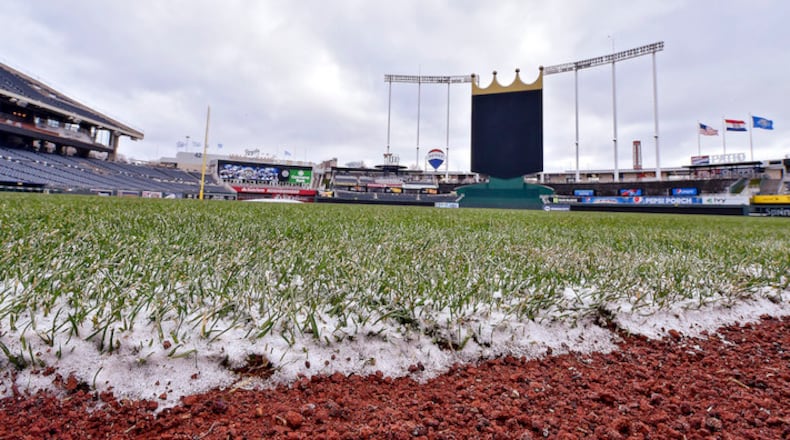"The swing starts a little slower."
Designated hitter Logan Morrison has the same problem.
"It's like they're swollen or something," Morrison said.
For center fielder Byron Buxton, the biggest difference trying to hit in wintry air is in his shoes.
"You always feel like something is tingling in your feet," Buxton said. "They feel heavy. You feel like your lower half can't produce like you want it to."
Most hitters in the Twins clubhouse have something that distracts them when they have to perform in the cold, whether it's feet, fingers, pine tar freezing on the bat or keeping muscles warm and ready to fire through the strike zone.
But by now, they should be used to the cold.
These opening weeks have been especially adventurous when it comes to the conditions. Rarely have the Twins had to play in the type of cold they have had to endure this season. Consider this: Since 2000, the Twins have had 30 games in which the game-time temperature has been 40 degrees or below, and six of those games have come in the past two weeks, according to baseballreference.com. Games scheduled for Friday, Saturday and Sunday were postponed because of sleet and snow.
"Me coming from Georgia, I've never played in cold conditions as I did now," Buxton said. "But 40 degrees right now is warm to me. ... Just give us 40 degrees. Get us out of the 30s. Just give us 40. It feels like a heat wave to us."
Buxton has good reason to hope for 40-degree weather. Since 2000, which is as far back as Baseball Reference has accurate weather data, the Twins have hit just .227 and .6 home runs per game on days 40 degrees or colder — .236 with four home runs in the six games this season. The major league average in those same conditions is .242 with .733 home runs per game across 2,884 games.
Thirty games is a small sample size, but if you ask the Twins, there's a reason batting average skews lower instead of higher in cold-weather games. It's harder to get loose and stay loose to reach maximum potential at the plate.
"When you're freezing, the swing is different," Escobar said. "It's freezing. You're freezing and your whole muscles are freezing."
Other Twins echoed Buxton and are ready to break out the beach balls and grills when the thermometer gets into the 40s like it was for Wednesday's 44-degree day game against the Astros. Since 2000, the Twins have hit .242 in games between 41 and 50 degrees while clobbering 0.75 home runs per game.
"Having the sun out there gives you a little blind optimism at least," pitcher Jake Odorizzi said.
It might be no coincidence that game ended up 9-8 with the bats coming alive after Tuesday's night game began at 39 degrees and went down from there.
"A low-40-degree game in Florida, you'd be shivering and then (Wednesday) everyone was somewhat overjoyed to be out there with one less layer," manager Paul Molitor said.
But for as good as the 40s may feel, the biggest jump comes between games played in the 50s to games in the 60s. Between 51 and 60 degrees, the Twins' average is .244 with .67 home runs per game since 2000. Between 61 and 70 it's a .264 average with .89 home runs per game. The average and home run rates climb in small increments with the temperature.
Pitchers also face problems in cold weather. They can lose velocity, and the ball can become harder to grip.
"Once you get in the 30s, you take your hand out of your pocket and it gets cold," Odorizzi said. "Imagine trying to have a feel for a baseball, trying to spin it and this and that when you can't really feel your hand. It's a very difficult thing to locate and do."
But reliever Zach Duke conceded pitchers might have the upper hand in the cold vs. batters.
"Honestly, for the hitters, the pine tar is not sticky when it's cold," Duke said. "A lot of times hitters will end up gripping the bat more firmly than they usually do just to make sure the bat doesn't slide around."
Morrison said he and others put "lizard skins" on the grip of the bat to try and counter this, but the feel just isn't the same as it is under normal conditions. It's also a challenge to stay warm — the warmth from heaters in the dugout usually fades while a hitter is waiting in the on-deck circle. But it's still worth the attempt.
"Sometimes the guy in front of you has a long at-bat and you're standing on the on-deck circle and it gets cold," outfielder Ryan LaMarre said. "It's more the preparation for the at-bat. It's running in from the field, making sure you get your hands, bat, helmet all warmed up when you go out there."
Only to have everything go cold again.
About the Author
